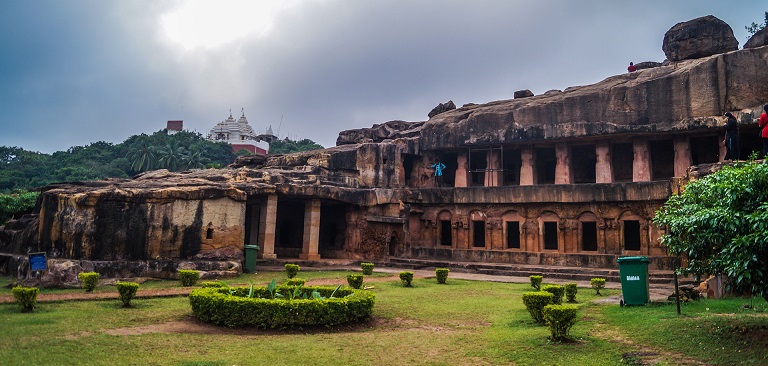If you are a history enthusiast or a travel lover seeking to explore the rich cultural heritage of India, then a visit to the magnificent Khandagiri and Udayagiri Caves in Bhubaneswar is a must. These ancient caves, dating back to the 1st and 2nd century BC, offer a fascinating glimpse into the architectural brilliance and religious significance of the bygone era.
The Khandagiri and Udayagiri Caves are located on twin hills, and they are a testament to the artistry and devotion of ancient craftsmen and religious practitioners. Carved out of rock, these caves served as dwelling places for Jain monks and hold great historical importance. They feature intricate rock-cut carvings, stunning sculptures, and inscriptions that depict tales of the past, making them a treasure trove of history and spirituality.
Exploring these caves allows you to connect with the spiritual and artistic heritage of India while immersing yourself in the stories and beliefs that shaped the lives of those who inhabited them centuries ago. It’s an opportunity to step back in time and appreciate the enduring legacy of India’s ancient civilizations. In this post, we will take you on a virtual journey to explore the history, architecture, and significance of these marvelous caves.

Post Contents
History of Khandagiri and Udayagiri Caves
The Khandagiri and Udayagiri Caves hold immense historical and cultural significance. These caves were commissioned by King Kharavela of the Mahameghavahana dynasty, who ruled over Odisha during the ancient times. Originally, there were a total of 117 caves, but today, only 33 of them are found. Out of these, 15 caves are located in the Khandagiri Hills, while the remaining 18 are situated in the Udayagiri Hills. These twin caves are nestled in the picturesque Kumari Mountains, offering breathtaking views of the surrounding natural beauty.
The caves were primarily built as residential quarters for Jain monks who sought solitude and a peaceful place for meditation. Each cave was meticulously carved out of the rocky hills, showcasing the architectural brilliance of the time. The caves served as a sanctuary for the monks to find solace and enlightenment. They provided a place for them to rest, meditate, and practice their religious rituals.
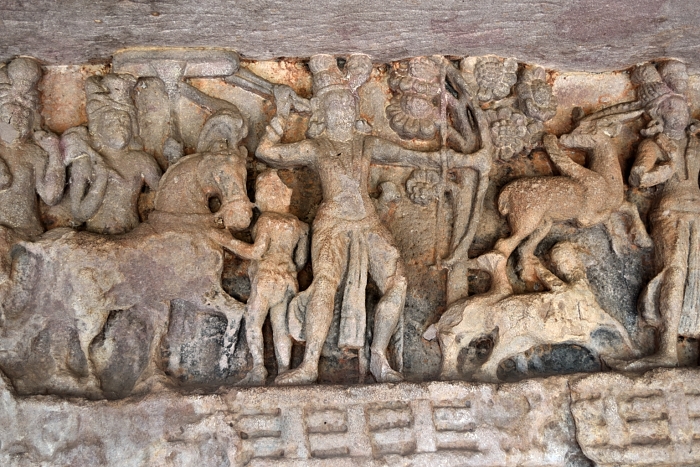
Related Article: Ellora Cave Monuments: Spirit of co-existance and religious tolerance through rock architectures
Architecture of Khandagiri and Udayagiri Caves
The architecture of these caves exemplifies the core principles and values of Jainism, emphasizing simplicity, spirituality, and a deep connection with nature. These cave structures, which are often referred to as Jain cave temples or monasteries, are remarkable examples of ancient Jain architecture.
- The low ceilings and unadorned interiors of these caves reflect the simplicity and humility that are central to Jainism. Jain monks embraced an ascetic way of life, and these caves were designed to be unpretentious and free from ostentation. The austere design encourages a focus on spiritual contemplation and inner reflection.
- These Jain caves typically lack the lavish decoration and ornamentation found in some other ancient Indian architectural styles. The absence of excessive ornamentation underscores the idea that true spiritual richness comes from within rather than external opulence. The minimalistic design promotes an environment of serenity and tranquility.
- While the caves themselves may be simple, the walls are often adorned with intricate sculptures that serve as both artistic expressions and educational tools. These sculptures depict various aspects of Jainism, including deities, religious symbols, and historical narratives. They provide a visual means for teaching and preserving Jain beliefs and stories.
- One of the most astonishing aspects of these cave temples is that they were carved entirely by hand using basic tools. The absence of advanced machinery or technology during the time of their creation showcases the incredible skill, dedication, and craftsmanship of the artisans who meticulously carved these structures into the rock. This manual labor-intensive process is a testament to the devotion and patience of the builders.
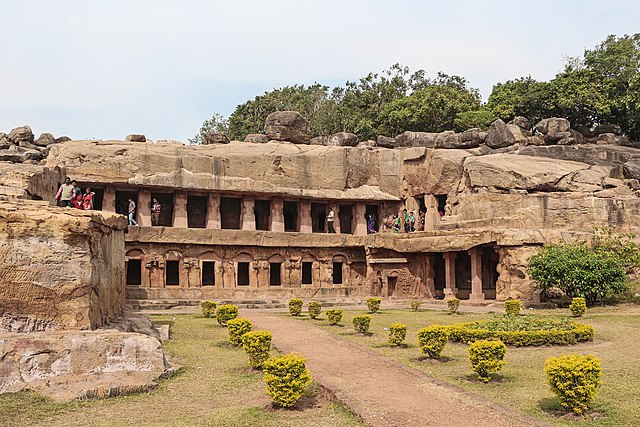
Exploring Udayagiri Caves
Udayagiri, meaning the “Hill of Sunrise,” is home to 18 caves that offer a glimpse into the rich history and religious practices of ancient times. Each cave has its own distinct features and significance. The caves in Udayagiri are relatively well maintained compared to the ones in Khandagiri. Let’s delve into some of the notable caves in Udayagiri:
Cave 1 – Rani Gumpha (Queen Cave)
Cave 1, also known as Rani Gumpha, is indeed one of the most remarkable caves in the Udayagiri complex. While it may not be renowned for its architectural complexity, this cave is celebrated for its ancient and exquisite sculptures. Here’s a more detailed description of Rani Gumpha and its features:
Rani Gumpha is a two-story cave, and each floor is organized into three wings. The central wing on both floors is notably larger than the side wings. On the lower floor of the central wing, there are seven entrances, making it the primary access point. On the upper floor, there are nine columns, suggesting a more intricate layout.
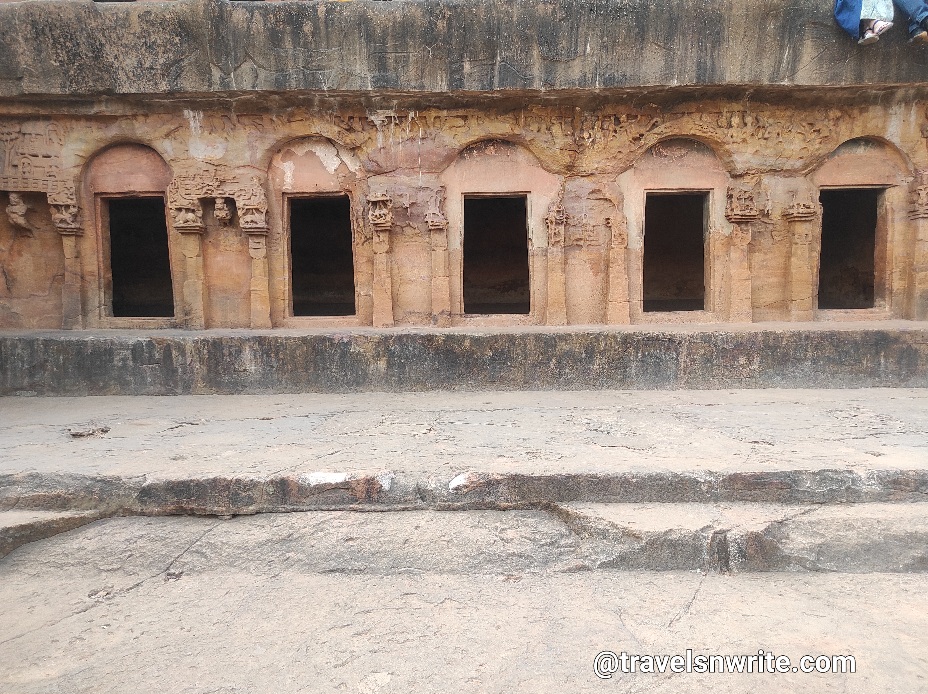
The upper portion of the central wing features relief images that depict a grand procession or the victory march of a king. These sculptures offer a glimpse into historical and cultural events of the time.
Many of the cells within Rani Gumpha contain intricately carved Dwara Pala images, which are guardian figures often found in Indian temple architecture. Some of these sculptures may be disfigured over time but still hold historical significance.
The connecting area between the central wing and the side wings is adorned with decorative panels. These panels feature sculptures of various elements, including wild animals, fruit-laden trees, human figures, women playing musical instruments, monkeys, and playful elephants. These elements provide a rich visual tapestry of life in ancient times.
The pilasters within the cave are decorated with torana, which are arches adorned with sculptures of both Jain religious importance and royal scenes. This demonstrates the fusion of religious and secular art within the cave.

Related Article: A trip to the Udayagiri caves near Bhopal
Cave 2 – Hathi Gumpha (Elephant Cave)
Hathi Gumpha or the Elephant Cave is a natural cave which is architecturally the most insignificant in the whole Udayagiri cave complex. The most prominent feature of Hathi Gumpha is the inscription that dates back to the reign of King Kharavela, who ruled the Kalinga region around the 1st century BCE.
This inscription is of immense historical value as it provides valuable insights into the king’s reign, military conquests, and achievements. King Kharavela is known for his significant patronage of Jainism and for his exploits in ancient India.
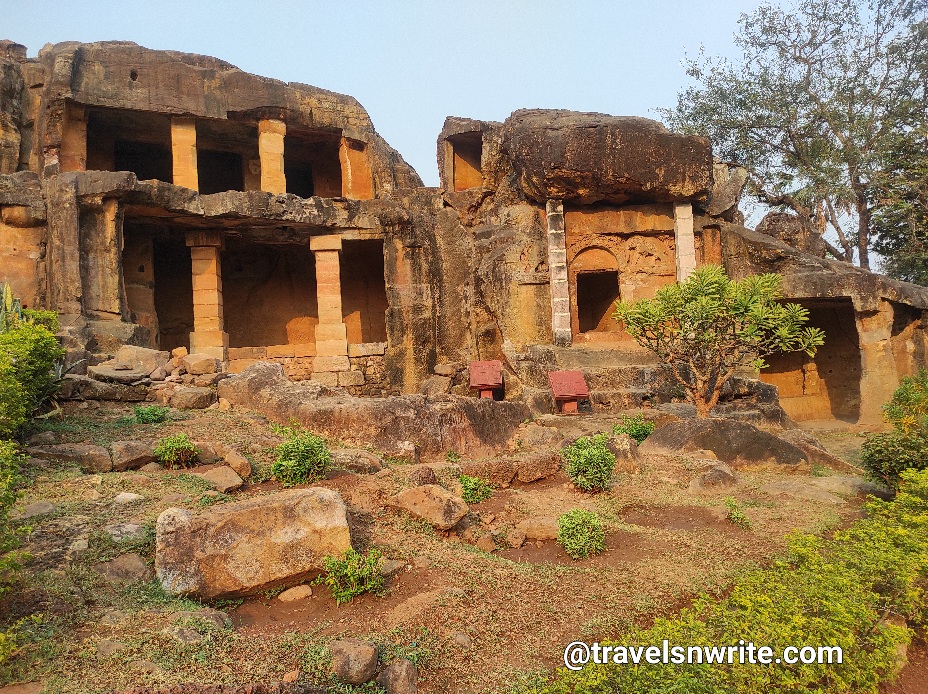
Cave 5 – Jaya Vijaya Gumpha
Jaya Vijaya Gumpha is a historically significant archaeological site known for its architectural brilliance located in the Udayagiri Caves complex. This double-story cave is renowned for its connection to Jainism and has been used by Jain monks for meditation and other religious activities.
The name “Jaya Vijaya” itself refers to two of the prominent guards or dwarapalakas of Lord Vishnu’s abode in Hindu mythology. However, the cave’s significance primarily lies in its intricate carvings and sculptures, particularly those of various animals including lions and bulls. These carvings showcase the exceptional craftsmanship and attention to detail of the ancient artisans who created this architectural marvel.
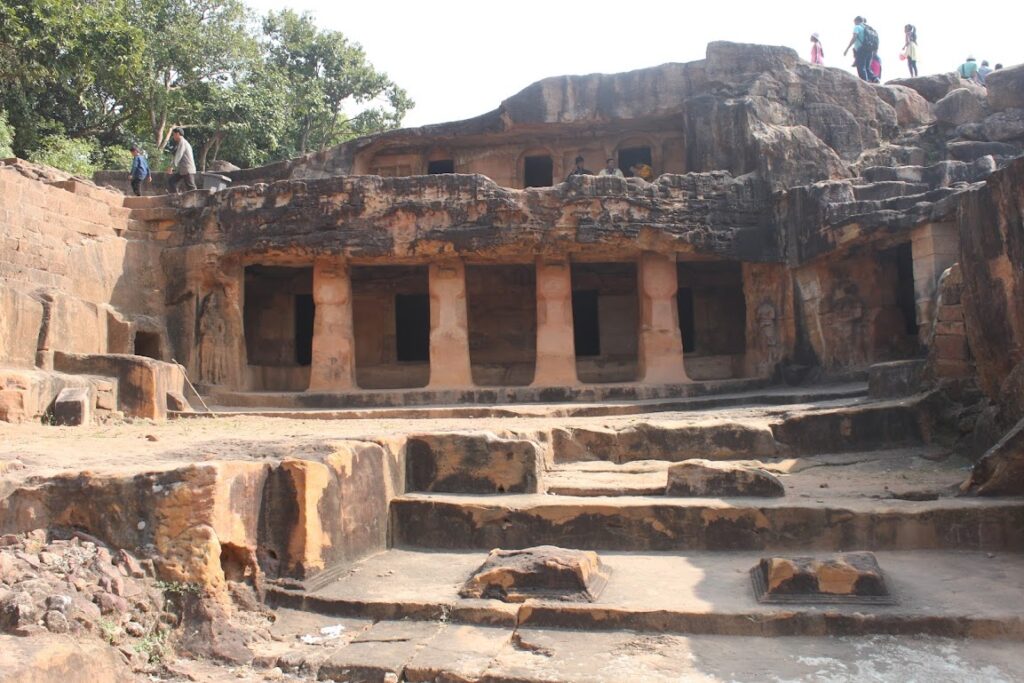
Cave 9 – Manchapuri and Swargapuri Gumpha
The Manchapuri and Swargapuri Gumpha are fascinating double-storeyed caves with rich historical significance. Manchapuri cave features carvings that depict two male and two female figures engaged in worship of the Kalinga Jina, a revered religious figure brought back by Kharavela from Magadha. This cave also contains a damaged Jain religious symbol, likely used for rituals and worship.
The inscriptions found in these caves provide valuable historical insights. One inscription talks about the chief queen of Kharavela, shedding light on the royal context. The other two inscriptions are related to Kudepasiri, Kharavela’s successor, and Badukha, believed to be either his son or brother. These inscriptions serve as historical treasures, offering a glimpse into the region’s past.
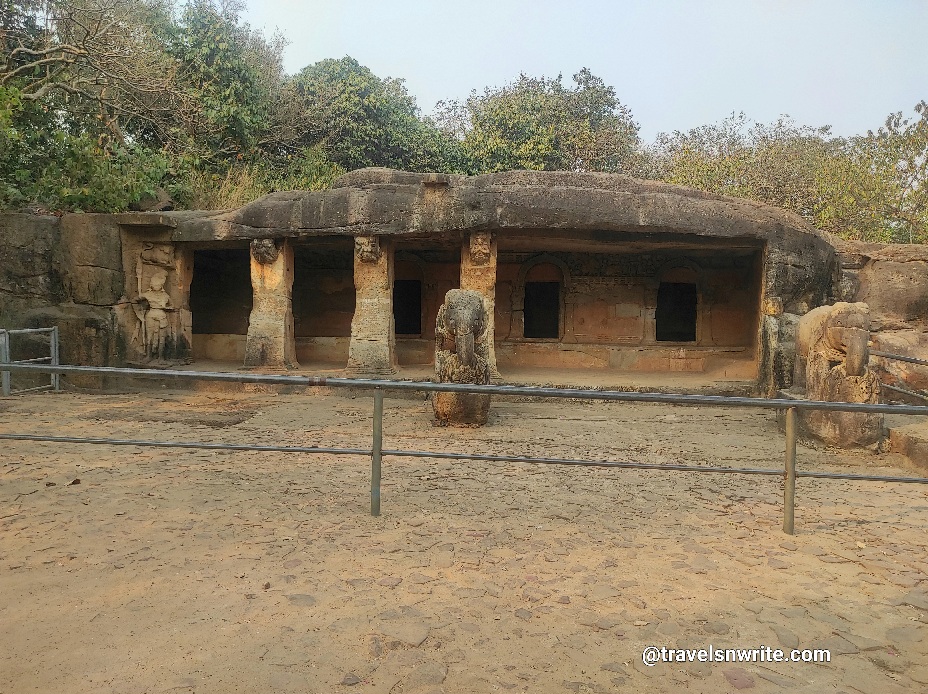

Cave 10 – Ganesh Gumpha
Ganesha Gumpha is an important cave in the Udayagiri complex from history and architectural point of view . Named after the carved figure of Lord Ganesha adorning its right cell, it’s essential to note that this intricate artwork was likely added during a later period and isn’t an original work. As you enter the cave, you’re greeted by two imposing elephant statues, bearing garlands, which serve as unique guardians at the cave’s threshold. This is a pioneering example of using sculpted animals as gatekeepers.The entrance to the cave has been cordoned off with petal poles.
Furthermore, the cave entrance is also adorned with carved figures of dwara palas, emphasizing its symbolic and protective role. Inside, the cave’s exquisite carvings narrate the captivating story of Princess Bassavadatta’s elopement from Ujjayini with King Udayana of Kausambi, accompanied by Vasantaka. These ancient narratives offer a glimpse into the rich history and artistry of the region.

Do Read: A Walking Tour of Bhimbetka Rock Shelters and Prehistoric Cave Paintings
Cave 12 – Vyaghra Gumpha
Also known as Bagha Gumpha or Tiger Cave, it boasts an entrance artfully sculpted to resemble a fierce tiger’s mouth, with the single-cell chamber extending into what looks like the tiger’s throat, showcasing the artistic mastery of ancient craftsmen. This distinctive feature has made it one of the most photographed sites in the Udayagiri Cave complex.
The very name, “Vyaghra,” signifies “tiger” in the local language, underscoring the significance of this cave. Furthermore, an inscription found within reveals that this cave was once the property of Sabhuti, a respected city judge from a bygone era, adding historical depth to its allure.
There are several other caves in the Udayagiri cave complex which holds historical, religious and architectural significance. These caves include Sarpa Gumpha, Alakapuri Gumpha, Jagannath Gumpha, Haridasa Gumpha, Bajaghara Gumpha, Dhanaghara Gumpha, Chhota Hathi Gumpha etc.
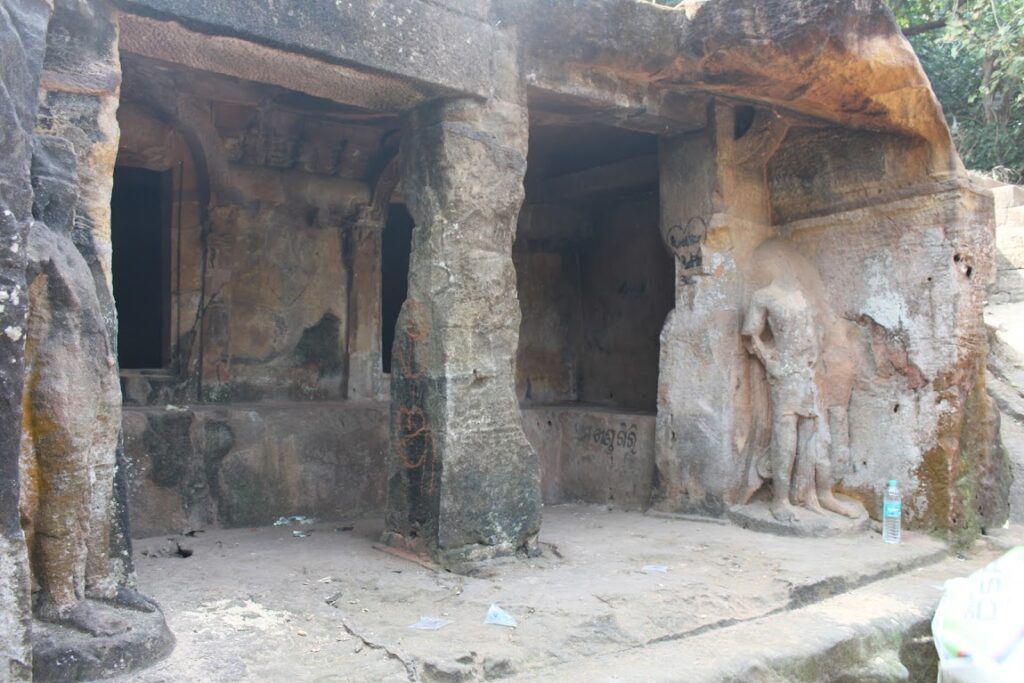
Discovering Khandagiri Caves
Opposite Udayagiri, the Khandagiri caves are equally captivating and hold a special place in the hearts of visitors. Let’s dive into some of the remarkable caves in Khandagiri:
Cave 1 – Tatowa Gumpha
Tatowa Gumpha, the first cave you encounter at Khandagiri, is a remarkable one for ancient Indian craftsmanship. Its entrance is adorned by imposing Dwara palas, while intricately carved lions, bulls, and parrots embellish the archway, showcasing the artistic prowess of the era. These vivid sculptures and carvings provide a glimpse into the cultural and artistic heritage of that period, offering modern visitors a window into the past.
This cave gets its name from the word parrot, as there is a stone-carved parrot at the entrance. However, you can’t spot it now. Maybe it was once visible but has since worn away.

Cave 2 – Tatowa Gumpha
Much like the first cave, this Tatowa Gumpha also boasts a rich display of detailed carvings and sculptures. It features a central chamber accessed through two pillars and three doorways. The cave’s walls are etched with the remnants of stone cravings which shows the exceptional artistic talents of the ancient craftsmen who left their indelible mark on this masterpiece.

Also Read: Sanchi Stupa: All you need to know about this Buddhist treasure
Cave 7 – Navamuni Gumpha
Navamuni Gumpha in Khandagiri Cave complex is a roughly hewn rock-cut cell. This remarkable cave is named after the sculptures of nine revered Jain Tirthankaras, who are central figures in Jainism, along with depictions of Sasana Devis, divine Jain goddesses. What makes this cave even more intriguing is that these beautiful carvings were added in the 11th century, during the reign of the Somavamshi dynasty.
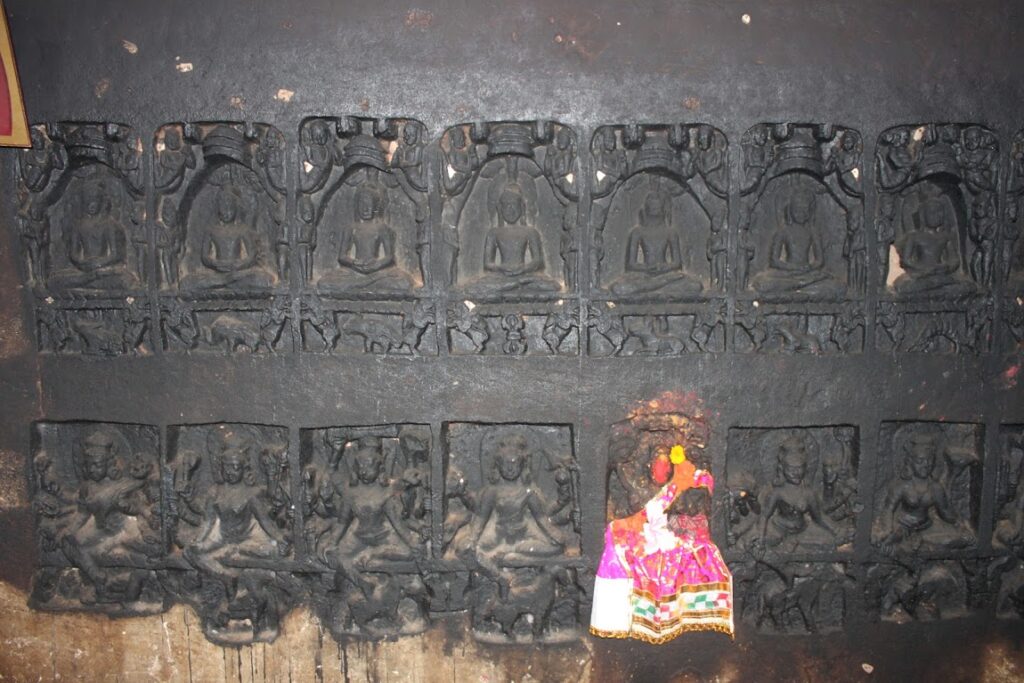
Cave 8 – Barabhuji Gumpha
This very important cave in the Khandagiri Complex has twenty-five sculpted figures of Tirthankaras, including the repetition of Parsvanatha.The inclusion of Sasanadevis alongside the Tirthankaras demonstrates the importance of these divine consorts in Jain iconography, symbolizing their roles as spiritual companions. Chakareswari, with her twelve arms, adds an intriguing dimension to the cave, earning it the name “Barabhuji,” reflecting her unique and powerful representation.
The dating of these sculptures to the 11th century, attributed to the Somavamshi dynasty, offers historical context, placing them within a specific period of Indian history. This further enriches our understanding of the cave’s heritage and the religious and artistic influences of that era.
Overall, these sculptures serve as valuable artifacts that reveal a fascinating tapestry of religious, cultural, and historical elements.
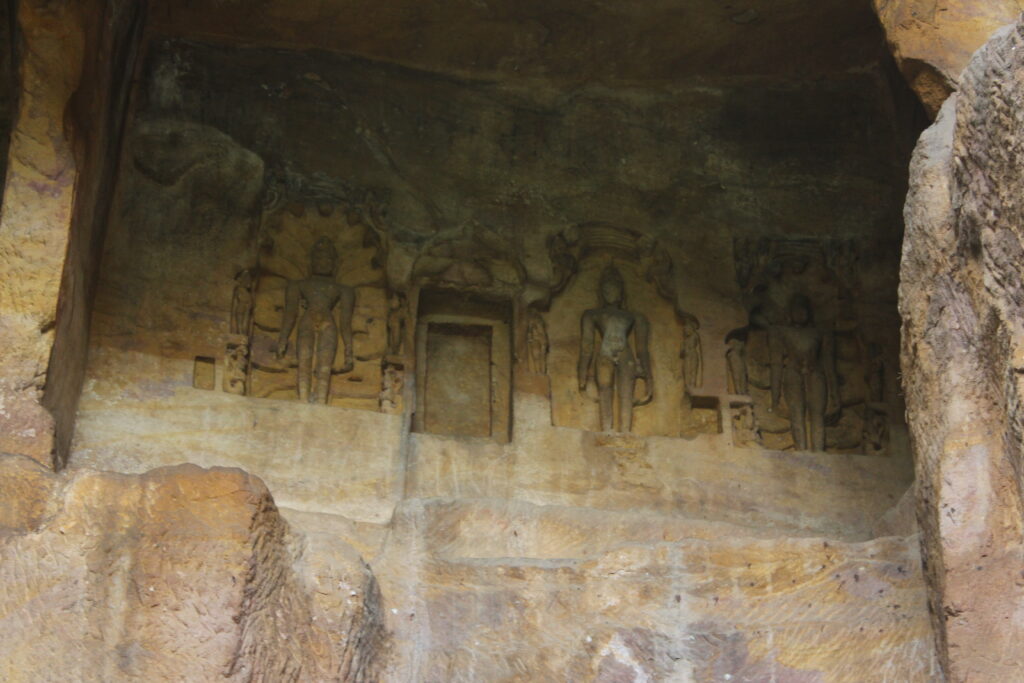
Cave 11 – Lalatendu Keshari Gumpha
This cave, the last one in this section, resembles the previous caves with portions of the original cave now collapsed. In this dimly lit space, most of the stone sculptures are on the upper sections, with no visible floors remaining. The cave has two chambers. The right chamber holds three reliefs, featuring two depictions of Rishabhantha and one of Parshvanatha.
The left chamber showcases five sculptures, including two representations of Rishabhantha and three of Parshvanatha. These ancient artworks offer a glimpse into the rich artistic and religious history of the region.
The Khandagiri complex also features several other caves notables among which are Ambika Cave, Ananta Cave, Khandagiri Cave, Tentuli Cave and Dhyana Cave. Caves no 12, 13 and 15 are unnamed.
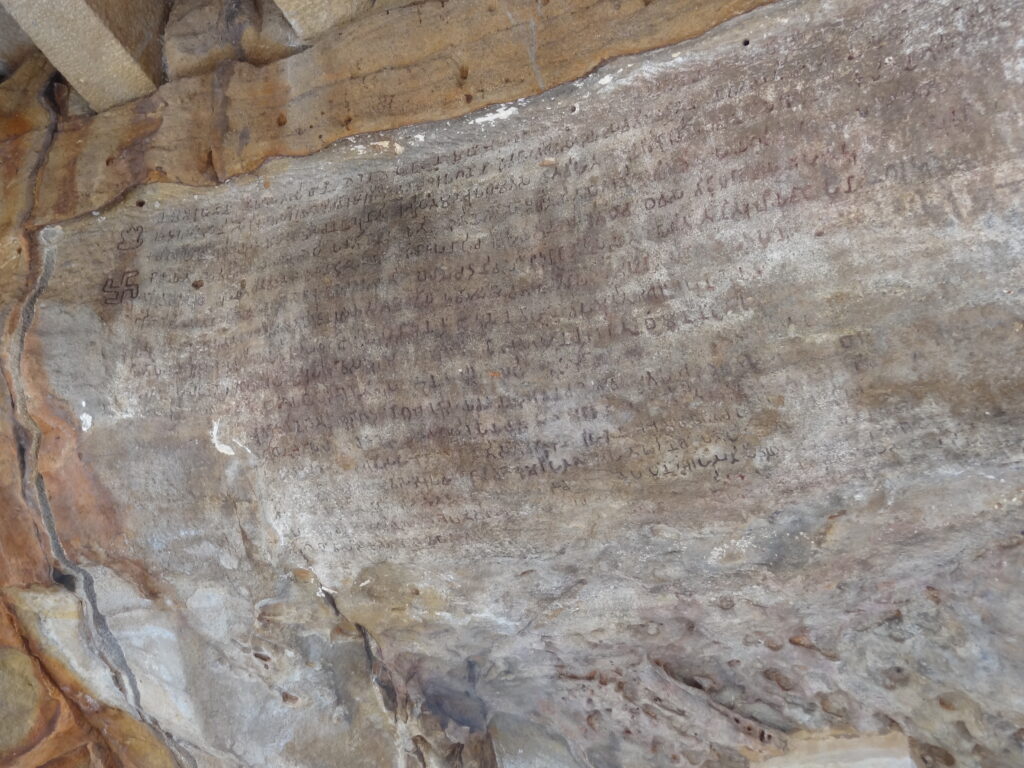
Do Read: Bodh Gaya travel: A self-enlighening journey into the land of Buddha
Inscriptions at The Khandagiri and Udayagiri Caves
One of the most intriguing aspects of the Khandagiri and Udayagiri Caves is the presence of inscriptions that provide valuable insights into the past. The Hathi Gumpha inscription, believed to have been carved during the 2nd century BC, is considered the most important inscription in these caves. It narrates the reign of King Kharavela and his accomplishments, shedding light on the political, social, and religious conditions of that era.

Other notable inscriptions can be found in the Mancapuri and Sarpa Gumphas. These inscriptions depict the love story of King Kharavela with his second wife and his encounter with Alexander the Great. The inscriptions are written in Prakrit language using Brahmi script and reflect the influence of Jainism, which played a significant role in the history of Odisha. They serve as important records of the kingdom’s history and provide valuable insights into the cultural and religious practices of the time.
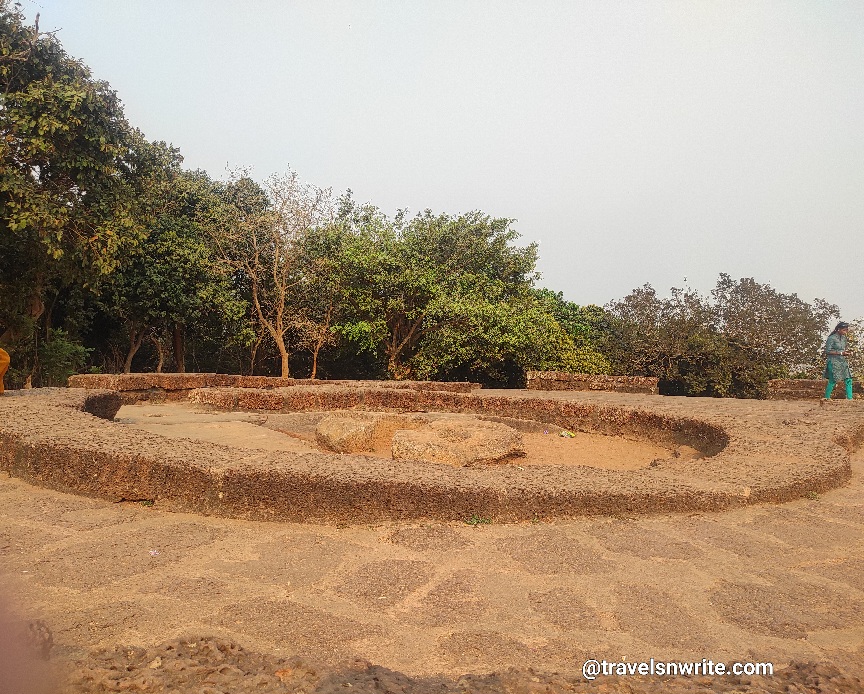
Travel Tips for your Visit to Khandagiri and Udayagiri Caves
If you are planning a visit to the Khandagiri and Udayagiri Caves, here are a few essential tips to ensure a memorable experience:
- The entry fee for India and SAARC country nationals is Rs. 25, while for foreign tourists, it is Rs. 300. There is no entry fee if you want to visit only Khandagiri caves. The caves are open from 8 am to 5 pm throughout the week.
- The ideal time to visit the caves is from November to February when the weather is pleasant and suitable for exploration.
- It is advisable to wear comfortable clothing and footwear as you will need to climb stairs and navigate through uneven terrain. Avoid wearing high heels or stilettos as they can be impractical and uncomfortable.
- Photography is allowed inside the caves, so don’t forget to bring your camera to capture the breathtaking carvings and sculptures. However, please be mindful and respect the sanctity of the place.
- Carry a water bottle and some snacks to keep yourself hydrated and energized during your visit. There are no food stalls inside the caves, so it’s best to come prepared.
- Bhubaneswar is well-connected by air, rail, and road. The Biju Patnaik International Airport is the nearest airport, and the Bhubaneswar Railway Station is the closest railhead. From there, you can hire a taxi or take a local bus to reach the caves.
- To enhance your understanding of the historical significance and architectural details of the caves, consider hiring a local guide who can provide insightful information and anecdotes.
- Bhubaneswar is home to several other historical and cultural attractions, such as the Lingaraj Temple, Raja Rani Temple, and Dhauli Shanti Stupa. Plan your itinerary accordingly to make the most of your visit to this culturally rich city.
Conclusion
A visit to the Khandagiri and Udayagiri Caves in Bhubaneswar is a truly enriching experience. These ancient caves offer a captivating journey into the past, showcasing the architectural brilliance and religious devotion of the era. With their intricate carvings, stunning sculptures, and historical inscriptions, these caves provide a unique window into the rich cultural heritage of Odisha. So, plan your travel, immerse yourself in history, and explore the majestic Khandagiri and Udayagiri Caves for an unforgettable adventure.

